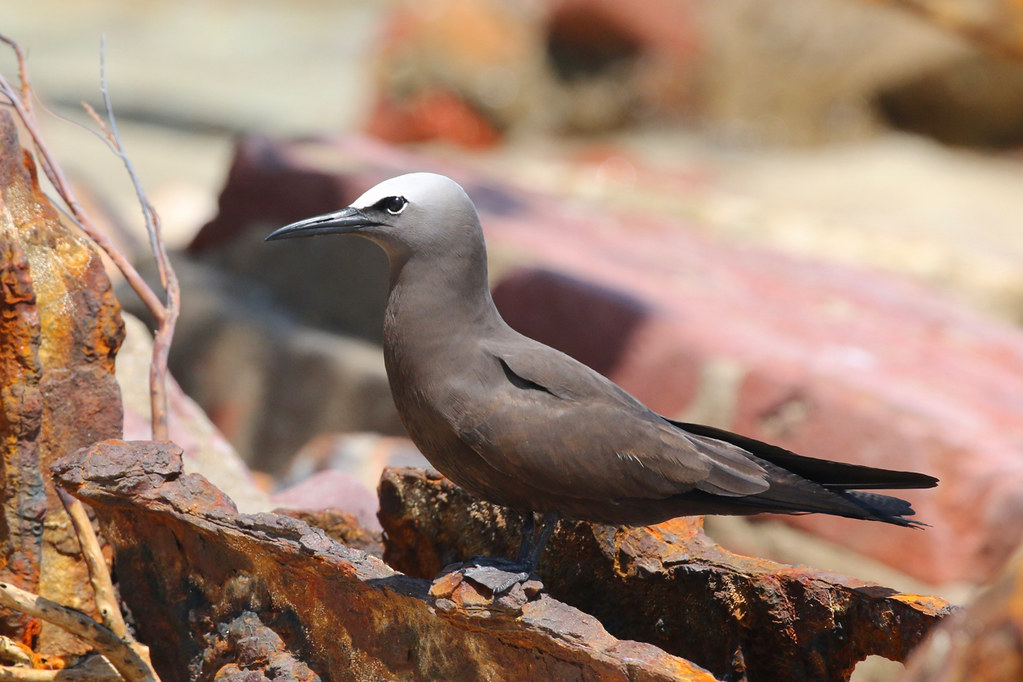
The subtropics is a transition between the actual tropics and the temperate zone. In the United States this zone extends from south Florida through south Texas and across the bottom of New Mexico and Arizona to a part of California from perhaps Santa Barbara south to Mexico. But in the U.S., south Florida is the only humid part of this latitudinal zone; it extends like a big toe dipping down into the rest of the Caribbean. The Gulf Coast of Texas is admittedly humid, but it doesn’t have the proximity to the island flora and fauna that Florida does. So much life comes floating up the Gulf Stream or gliding along on the westerlies.
I am presently enjoying the early spring warmth of southern Florida, the first visit I’ve made since 1996. I initially thought I might like to write about the exotic species one finds here, the parrots, orioles and bulbuls that escape their cages and settle in the cities and suburbs of the Floridian Atlantic. But aside from Eurasian collared doves, I have not laid eyes on anything of note. So, instead I will dwell on the biogeographic extension of the Caribbean northward onto the American mainland.
The species with perhaps the most tenuous toehold in North America is not on the mainland. The brown noddy (Anous stolidus), a dun-colored tern with a white forehead, at present breeds only on Bush Key in the Dry Tortugas, the collection of uninhabited islands at the very western end of the Florida Keys. These are mostly tropical birds that feed over warm ocean waters, not diving into the water like other terns but swooping or gently dipping into the surface (as Sibley has it) to pluck out their prey, small fish and squids. It and the related black noddy breed on isolated islands in the tropical Atlantic, Indian, and Pacific oceans. Again, unlike other terns, it builds its nest in a tree or on docks, jetties, or pilings. Black noddies are occasionally seen among the brown noddies in the Dry Tortugas, but are not (yet) regular breeders in the U.S.
The snail kite (Rostrhamus sociabilis) is widely distributed and locally common in the Caribbean and Latin America, but found only in peninsular Florida in the U.S., where it is rare here because the wetland habitat it requires has been fragmented and eliminated. It feeds only on apple snails, which in turn require this habitat. It seems unlikely to expand it range northward.
The white-crowned pigeon (Columba leucocephala) is found from Guadeloupe in the Lesser Antilles, north and west through all of the Greater Antilles and the Bahamas, but on the mainland U.S. is seen only in the Florida Keys and along the Atlantic coast as far north as Miami. While the species nests in the intertidal mangrove forests, it forages inland in the mixed evergreen-deciduous forests where there are abundant fruit-bearing trees. In most of its range it is a permanent resident, but the south Florida population retreats southward for the winter. While it is able to find in the southernmost U.S. a floral assemblage very much like the one its Caribbean populations prefer, it apparently finds the Florida winters a little too brisk and these birds mostly retreat to the Bahamas, but a few go to Cuba as well.
There are two species of ani that look very much alike. The smooth-billed ani (Crotophaga ani) is found in south Florida, while the groove-billed ani is a Mexican species, reaching the U.S. in south Texas. This species is found throughout tropical and south subtropical South America, east of the Andes and throughout the Caribbean. It occurs in Florida north to Palm Beach County on the Atlantic and Tampa Bay on the Gulf, although it has recently declined in numbers on the latter coast. The birds are entirely black with long floppy tails and very high-ridged bills. Despite their coloration, they are related to cuckoos, particularly the North American species, although relationships among cuckoos are uncertain. Anis, throughout their extensive range, are found in savannas, that is, grasslands dotted with trees, but also in suburban and urban areas and second-growth scrublands. Normally a very social bird, a pair or a small group will split from the flock and go off to build a cup-shaped nest in a tree, preferably one that is dense and thorny.
Another member of the cuckoo clan, the mangrove cuckoo (Coccyzus minor), is found along the coast of northern South America from the Guineas to northern Brazil and along the coasts of Central America and Mexico. South Florida, as with the species above, represents the northern limit of its Caribbean distribution. It is found as far north as Tampa Bay on the Gulf Coast but only as far as Miami on the east. In the U.S. it is largely restricted to coastal mangrove forests, but in most of its range it occupies a variety of lowland habitats. This species resembles a yellow-billed cuckoo, but is larger with a longer tail, a buffy belly, and thick black line from the beak through the eye.
The gray kingbird (Tyrannus dominicensis) is found from northern South America through all of the Caribbean islands, including the Bahamas, and appears to have crossed over to the U.S. mainland as recently as the 1920s. It has spread rapidly up both coasts of the panhandle in Georgia and Alabama. The range map in David Sibley’s Guide to Birds (2000) shows it only in south Florida and it is still most common there and spreading inland. In Florida it is, like the white-crowned pigeon, largely confined to mangroves to breed and ranges inland a little to dry, open areas with scattered palmettos or open pine forests. It has now extended its range north of the distribution of both mangrove species, showing that it is not confined to them, which is also the case in the Caribbean.